A general and a prisoner, a hero and a traitor, a bigamist, a Frankist, a sharp and a freemason. He deserved most of these terms by the time he was thirty. He fought in three armies, had five wives, and all of Warsaw danced at his balls. He was a disgrace to the Republic of Poland, but one thing must be admitted - he definitely added color to it.
This man's biography is actually a ready-made script for a Hollywood blockbuster. If a film about him were actually made, it would start like this:the year is 1800. In the shelter in Trzęsówka, a village forgotten by God and the people of a Subcarpathian village, an old pauper decides to tell his story. Everyone is shocked when a beggar clad in rags announces in a trembling voice: I am Prince Marcin Lubomirski and I had a life as amazing as the 18th century was ...
At first, nothing foreshadowed the complications that awaited him. A descendant of a magnate family, the only son of the crown swordfish Antoni Lubomirski, his start was easier. He studied at Collegium Nobilium under the supervision of Stanisław Konarski himself. Then he went to Luneville, France. Teenage Marcin made a sensation there. As one of the biographers wrote: he wore a Polish costume that raised his beauty in front of other youth in tight German dresses, with powdered heads .
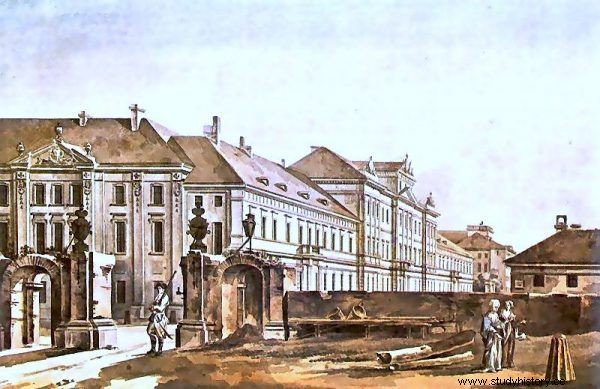
Marcin Lubomirski's education began quite inconspicuously - with Collegium Nobilium. Zygmunt Vogel's watercolor painting from 1788 (source:public domain).
Finally, he found his way to Paris, where he was swarming money left and right. And that was until his furious father ordered him to be brought into the bosom of his homeland.
It was at that time that the haidamaks, Ukrainian robbers marauding on the territory of Right-Bank Ukraine, were in the process of rebellion in the Republic of Poland. The young prince had the opportunity to show courage in combat, and because he came from a good family, he was appointed major general. He was only 18 years old and had a great career ahead of him. But then she appeared in his way…
A mediocre Lithuanian beauty and a war on two fronts
Lubomirski was convinced that Anna Wyleżyńska, an eighteen-year-old Lithuanian girl of wonderful beauty , Is the love of his life. Unfortunately, Wyleżańska was only the daughter of a teacup, and the saying "nobleman on the farm equal to the voivode" did not apply when the magnate's marriage was involved. The family would never agree to such a mismatch.
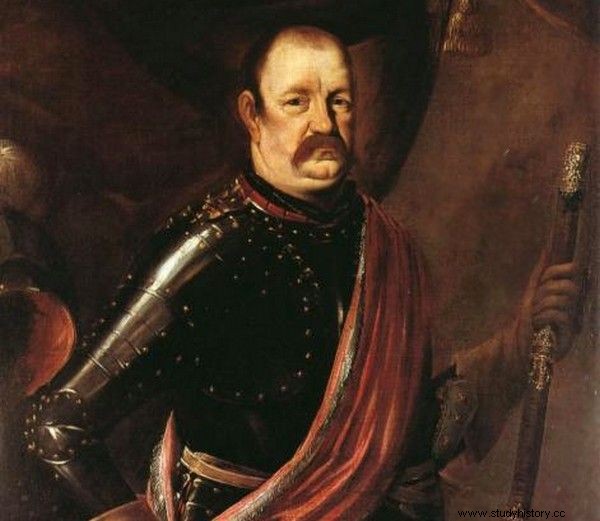
The Lubomirski family had belonged to the magnates for several generations, and it settled so well there that the wedding with the teacup's daughter was unthinkable. In the picture:Jerzy Sebastian Lubomirski, Marcin's great-grandfather (source:public domain).
Therefore Lubomirski gathered two hundred people, kidnapped the girl and in December 1757 he married her .
Cursed by his father and cut off from the family property, the prince had to make a living by being a soldier. Although the Republic of Poland was not involved in any conflict at that time, the Seven Years' War was taking place just beyond its western borders.
So Lubomirski joined the Prussian army fighting the Russians. He even fielded two regiments. However, the Prussians did not satisfy his ambitions - they did not want to pay him, nor did they offer a command. He therefore thanked for such cooperation and offered his services to the Russians.
From then on, he robbed Prussian contingents, taking a commission of twenty percent. After a while, he didn't care who he was stealing from. He also began to roam the Polish side of the border. To put it bluntly, the prince of the Lubomirski family became a robber.
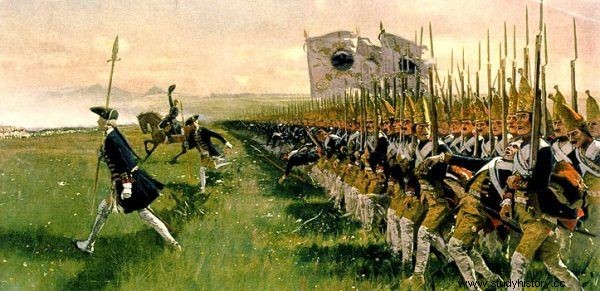
It made no difference to Lubomirski whether he was fighting on the Prussian side or looting it ... In the picture, an attack by Prussian infantry during the Battle of Dobromierz in 1745 (author:Carl Röchling, public domain).
The streak ended in December 1759. The prince, along with his wife and companions, fell into the hands of the Crown troops. The list of charges against the twenty-one-year-old major general was long. Kidnapping a noble woman, desertion, joining a foreign army, robbing merchants, killing one of them ... Maybe if the father had used his influence, it might have been possible to get out. But Antoni Lubomirski did not want to get involved in defending his son.
The sentence was:expulsion from the army, deprivation of all ranks, and life imprisonment. It could have been worse though - four out of fourteen judges voted for the death penalty.
He was locked up with one wife, he came out of prison with two ...
Mr. Lubomirski was taken to the fortress, Mrs. Lubomirska was locked up in a convent. It was only after some time that the prince's father's heart softened and he interceded for his son. Life imprisonment was changed to 15 years' imprisonment.
Initially, the ex-general was imprisoned in Białystok, but the Lubomirski family was so ashamed of the relative that he was taken abroad . Thus in 1763 the prince landed in a fortress in Buda, Hungary.
Lubomirski was then 25 years old, a handsome and self-confident man. No wonder that caught the eye of Annie Hadikównie, the young daughter of the fortress commander . An unfortunate man of fifteen years is usually a poor candidate for son-in-law. But this one was the exception. During his stay in prison, Marcin's father died and the ex-general was supposed to take over a huge inheritance. This is why Commandant Hadik began efforts to free the prince. In May 1765, Lubomirski left the fortress. Three months later he married Hadikówna.
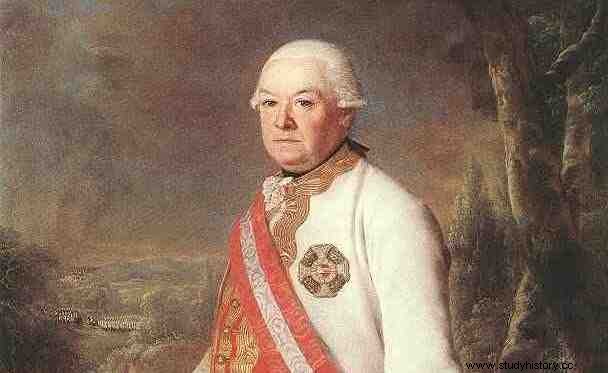
Andrzej Hadik - instead of watching over Lubomirski - made him his son-in-law ... (a painting by Johann Georg Weikert, public domain).
Like this Lubomirski became a bigamer, though there have been some incidents that obscure the situation. Apparently, the prince's first wife found out that the priest who married them was actually Marcin's friend in disguise. So she decided to enter the Vilnius convent and put on the Benedictine habit. It is not known whether the priest was really a disguise or whether it was a rumor spread by the Lubomirski family, who wanted to get rid of the Lithuanian woman and wipe the mark of the mesale from the relative. Anyway, the prince himself considered Wyleżyńska to be his first legal wife until the end of his life.
Lubomirski's second marriage, although it helped him regain freedom, did not last long. Marcin and Anna divorced, although the breakup took place in a friendly atmosphere. Hadikówna later became the mistress of King Stanisław August Poniatowski himself and even bore him a son.
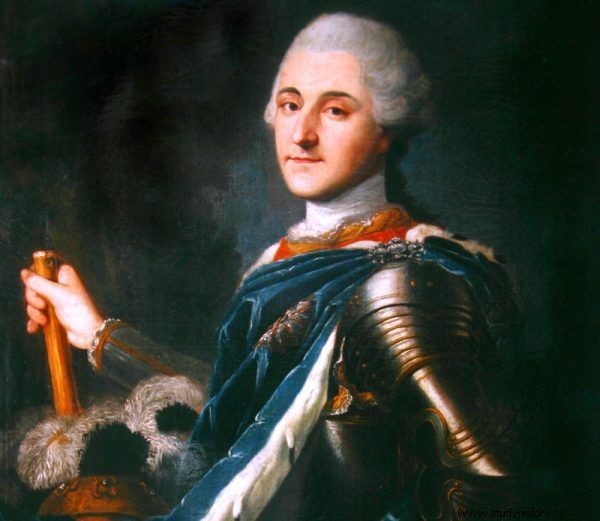
Anna Hadik did not despair for a long time after parting ways with Lubomirski. She found consolation in the arms of King Poniatowski himself (source:public domain).
From patriot to traitor
Meanwhile, in the Polish-Lithuanian Commonwealth, the Russians were becoming more and more arrogant. Eventually, it sparked a reaction from the nobility. The first national uprising broke out, known as the Bar Confederation. It was an amazing mixture of heroism, courage, patriotism, madness and frowning - a project created for Lubomirski . So he got involved with all of himself. He sacrificed a sea of money, even pawned his wife's jewels. He won several skirmishes, but every army he assembled was eventually broken up by the Russians ... or other Confederate factions.
The unfortunate commander sought refuge in the Carthusian monastery in Gidle (today's Łódź Province), from where he had to flee in peasant disguise, for fear of handing him over to his enemies. He wanted asylum in Austria, but was told to get out. Eventually he fled to Prussia.
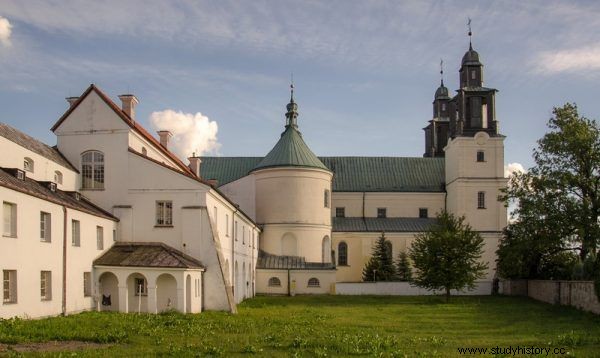
Monastery complex in Gidle. This is where Marcin Lubomirski took refuge after the failures of the Bar Confederation (photo:Sławomir Milejski, license CC BY-SA 3.0 pl).
With time, the situation in the country calmed down and Lubomirski was able to return to Poland. He even managed to regain his fortune, but the price was to cooperate with Antoni Poniński - the later Crown Treasurer and one of the greatest traitors in the history of Poland.
He started his political career in Poland, but his debut was extremely unlucky. The prince was elected in 1772 as a deputy to the Seym. The Seym, which turned out to be tragic. Lubomirski personally crossed Tadeusz Rejtan who was lying on the doorstep, he also signed the treaty of partition . He even became a member of the commission delimiting the Polish-Austrian border.
In order not to judge him too harshly, it should be remembered that in his later years he deserved a bit of his homeland. He even founded a foot regiment, for which he was nominated a lieutenant general of the Crown forces. He still had a lot of money, because he had drowned a lot in the Bar Confederation, but he got an inheritance from his childless uncle.
The problem is that he was able to squander his fortune in a truly princely style . As a result, in 1781 he published a table of debts. It had 1o pages with hundreds of commitments on them. In exchange for his properties, Adam Poniński took them over.
Theater, Freemasonry and Jewish Sect
Prince Marcin withdrew from public activity, devoting himself to other passions:theater, opera and playing cards. He rented the Radziwiłł Palace in Warsaw (today's Presidential Palace) and made it a gambling cave . There were balls, concerts and carnival parties. The new reputation of the prince reached far beyond the truncated borders of Poland - even in Paris he was entered into the register of gamers. Lubomirski's career in this industry ended in 1783, when was legally banned from gambling and the authorities forbade him to sell alcohol .
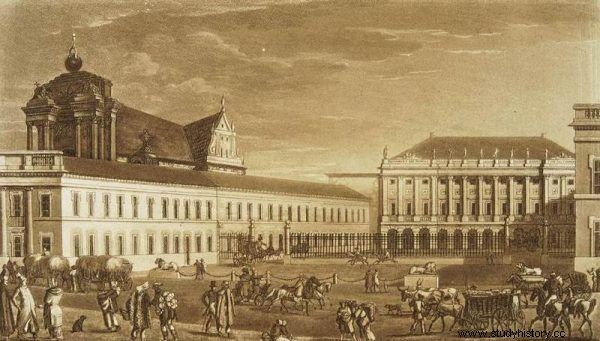
From the present Presidential Palace, Marcin Lubomirski turned into a gambling cave and party center. A postcard from 1820, when the building was called the Governor's Palace (a print by Frederick Dietrich, public domain).
The prince immediately found a new job. He organized a theater troupe and appointed Wojciech Bogusławski, the father of the Polish national stage, its director. In show business, Lubomirski felt like a fish in water , and in the cultural history of Warsaw he went down in golden letters, providing the residents of the capital with high-quality entertainment. Unfortunately, the prince's profligacy knew no bounds and he eventually went bankrupt.
Lubomirski's personal life was also far from stabilized. After divorcing his wife number 2, he entered into a marriage with the voivode of Kiev, but it also ended in divorce. Pressed by long, he left for Germany in search of the fourth Mrs. Lubomirska. This time, if possible, wealthy. It fell on the daughter of a Prussian general, with whom he quickly married (and parted just as quickly). During his peregrination in the lands of his western neighbor joined the Masonic Lodge .
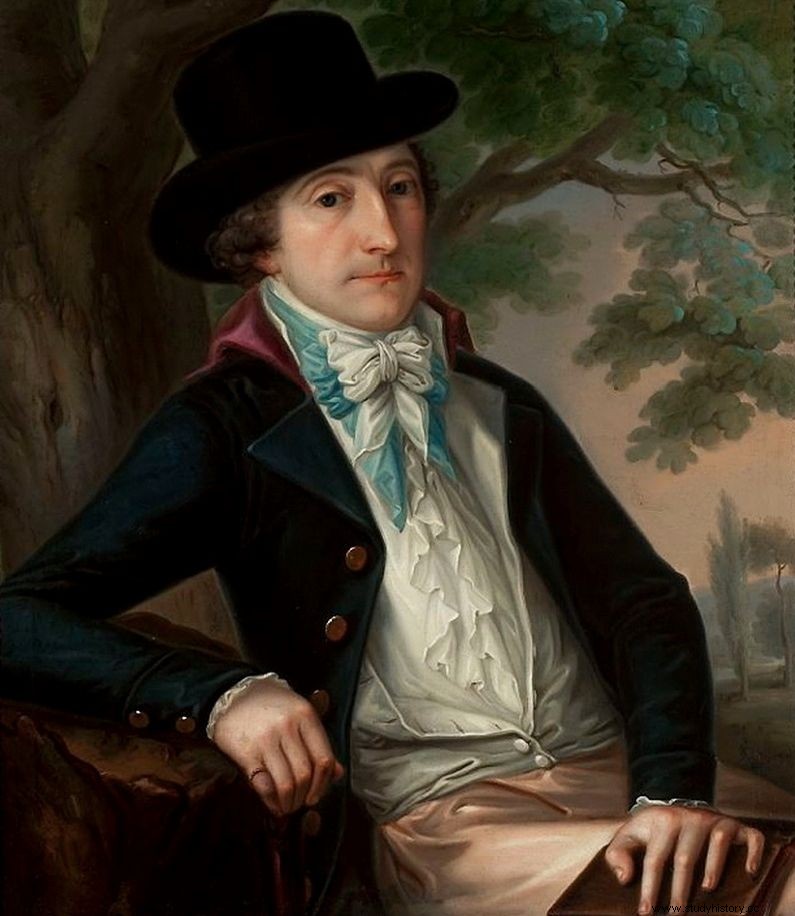
Marcin Lubomirski even engaged Wojciech Bogusławski in his undertakings (a painting by Józef Reichan, public domain).
Lubomirski was generally susceptible to the influence of various strange societies. On his next trip to Germany he became interested in the Jewish sect of Frankists . Its members saw in their leader, Jacob Frank, the promised Messiah. Soon it was said that the prince became half Jewish, and his daughter [i.e. Frank] understood . In fact, the next princess Lubomirska was not the beautiful Ewa Frankówna, but one of her friends. This does not change the fact that the prince was closely related to Frank, and in 1791 attended his funeral.
Then he was out of sight for everyone. The magnate, whose achievements were reported in European newspapers, was lost to water. One of the richest people in the Commonwealth squandered all his fortune and found his asylum, literally and figuratively, in Trzęsówka. According to various sources, he died in 1800 or 1811. As requested, he was buried at the doorstep of the parish church in Cmolas, to be trampled on by me (...) subjected to the guilt of life .
Sources and studies:
- Boniecki Adam, Reiski Artur, Polish Herbarz , vol. 15, Warsaw 1912, pp. 77-78.
- Chomętowski Władysław, The Adventures of Prince Marcin Lubomirski , Warsaw 1888.
- Dymnicka Hanna, Lubomirski Antoni Benedykt , [in:] Polish Biographical Dictionary , vol. 18, 1973.
- Kamecka Małgorzata, "Mamoryał Expens na Wojażu Kasztelaniców Bieckie" as a contribution to the research on the journeys of the Polish nobility in the 18th century , in: On the Old Polish Society, vol. 1, ed. K. Łopatecki, W. Walczak, Białystok 2007, p. 201.
- Kraushar Aleksander, Former Warsaw Palaces , Poznań - Warsaw - Vilnius - Lublin 1925.
- An open letter to Józef Piasecki, Member of Parliament and neighbor, from Henryk Łodz Brodzki , Krakow 1863.
- Niemcewicz Julian Ursyn, Memoirs of my times , Paris 1848.
- Skowroński Kazimierz, How did Mr. Kolbuszowa play the theater (and himself) and amused Warsaw , "Bulletin [of the Society for the Protection of Monuments of Nature and Culture. J. Goslar in Kolbuszowa] ”, No. 7, 1965.
- Szczygielski Wacław, Lubomirski Jerzy Marcin , [in:] Polish Biographical Dictionary , vol. 18, 1973.
- Wierzbicka-Michalska Karyna, Lubomirska Anna Maria z Hadików , [in:] Polish Biographical Dictionary , vol. 17, 1972.
